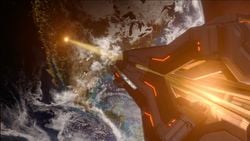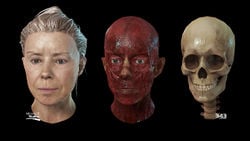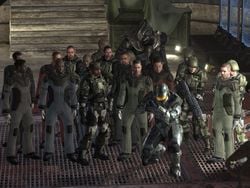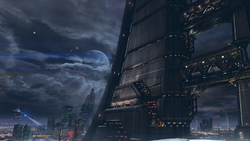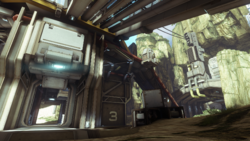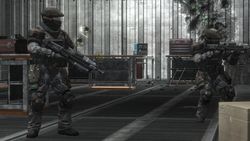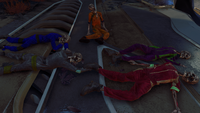Human: Difference between revisions
From Halopedia, the Halo wiki
| Line 355: | Line 355: | ||
==Sources== | ==Sources== | ||
{{Reflist|2}} | {{Reflist|2}} | ||
{{Template:Human species}} | |||
[[Category:Human| ]] | [[Category:Human| ]] | ||
[[Category:Sapient species]] | [[Category:Sapient species]] | ||
[[Category:Host species]] | [[Category:Host species]] | ||
Revision as of 23:37, May 26, 2019
| There is more information available on this subject at Human on the English Wikipedia. |
| Human | |
|---|---|

| |
| Biological overview | |
|
Latin name: |
Homo sapiens[1] |
|
Classification: |
Mammal |
|
Diet: |
Omnivorious |
| Physical information | |
|
Avg. height: |
152.4–182.9 cm (5–6 ft)[1] |
|
Avg. weight: |
61.2–90.7 kg (135–200 lb)[1] |
|
Avg. lifespan: |
80–90 years[1] |
| Sociocultural information | |
|
Homeworld: |
|
|
Notable individuals: |
John-117, Catherine Halsey, Avery Johnson, Jacob Keyes, Miranda Keyes, Preston Cole, Terrence Hood, Thomas Lasky, Chakas |
|
Also known as: |
|
|
Languages: |
|
Humans, taxonomically referred to as Homo sapiens (Latin for "wise man") and known as hamanune (plural hamanush) in the Forerunner era,[3] are a sentient species native to Earth. A part of the primate family, they are the only extant species of a formerly diverse genus of multiple species once classified as human. Members of the species, like some Covenant species, are four-limbed and bipedal, which enables them to walk upright on two legs and use their arms and hands (including opposable thumbs) to hold and manipulate objects such as tools.
Over 110,000 years ago, humanity had achieved a thriving interstellar civilization nearly on par with the Forerunners, although their catastrophic defeat in the human-Forerunner wars would see them reduced to a preindustrial state as hunter-gatherer tribes, forced to achieve technological sophistication again.[4] Thanks to the efforts of the Forerunner known as the Librarian, however, humans were later elevated to the role of Reclaimers, intended to inherit the Mantle the Forerunners used to hold. Humanity would not begin to rise from the confines of their homeworld until nearly 100,000 years later, with the re-invention of space travel in the mid-20th century and the beginning of space colonization in the later half of the 21st century. Following a series of violent conflicts across the Sol system, humanity at large was brought under a single banner with the establishment of the Unified Earth Government in 2170. Over a century later, the invention of the Shaw-Fujikawa Translight Engine heralded a new golden age for humanity: no longer confined to their home system, humans spread across the neighboring stars.[5]
At the end of the 25th century, this age of flourish was coming to an end, and the rising economic and political tensions across the colonies eventually culminated in a series of civil conflicts collectively known as the Insurrection. The war claimed millions of lives over the next three decades, but a far more dire threat loomed. In 2525, a theocratic alien hegemony known as the Covenant invaded the colony world of Harvest, beginning the apocalyptic Human-Covenant War.[5] For nearly three decades, humanity, under the emergency military governance of the United Nations Space Command, was pushed back by the relentless Covenant war machine, until the tide turned in 2552. With humanity teetering on the brink of extinction, the discovery of a Forerunner artifact known as Halo set in motion a course of events which would lead to the fragmentation and eventual destruction of the Covenant.[6]
Following the end of the war, humanity began to take on a more active role in the galactic community formed by the Covenant's dissolution, with new technological developments sped up by the discovery of Forerunner relics. However, these developments have not yet elevated them to the Tier 2 of technological advancement held by the Covenant.[1] Despite the defeat of the Covenant, humanity continued to be gripped by conflict in the post-war years. In addition to threats from within in the form of renewed dissidence across the colonies, the UNSC was involved in hostilities with resurgent Covenant factions and the Ur-Didact's reawakened Forerunner Promethean constructs.[7]
History
Prehistory
The origins of humanity lay in the ancient race of beings known as the Precursors. Responsible for seeding the galaxy with life, the Precursors genetically engineered early humanity along with many other species in the galaxy, including Forerunners, a would-be rival species to humanity.[8] The Precursors intended humanity to inherit the Mantle, their assumed role of guardianship for all life in the galaxy. The Forerunners refused to accept this decision and subsequently rebelled against the Precursors. After exterminating the Precursors to the point of extinction, the Forerunners claimed the Mantle for themselves, using it not only as the basis of their society but also as justification for securing their own dominance for millions of years.[9]
Modern humanity, Homo sapiens, is believed to have appeared in Earth's fossil record between approximately 100,000 and 200,000 years ago (an older branch of Homo sapiens known as Homo sapiens idaltu was believed to have lived as far back as 160,000 BCE). While the exact origin of humanity is a hotly contested paleontological debate, one theory is that the first humans evolved from a genus of upright ape-like hominids called Australopithecus (likely Australopithecus afarensis).
Homo sapiens is not the only species of human to have evolved on Earth, but they have either displaced or outlasted all other branches of the genus Homo, all species of which were once collectively known as "humanity". In prehistoric times, there was significant contact between anatomically modern humans and other members of the genus, both cultural and genetic, coexisting with species such as Homo erectus, neanderthalensis and floresiensis, and, based on residual genetic evidence, interbreeding with other species (1-4% of the DNA in European and East Asian humans is Neanderthal, while Melanesian people have 4% of Denisovan blood).
Early civilization and Forerunner involvement
- Main articles: Prehistoric human civilization, Erde-Tyrene civilization
Humanity achieved an advanced state early in its history, well over 1,100,000 BCE,[10] when their earliest, long-forgotten cultures attained space travel and spread across many worlds. The latest of these early civilizations, having risen to power around 150,000 BCE after a series of technological dark ages,[11] eventually reached a level of technological sophistication close to that of the Forerunners. Humans of this era were on average larger and superior to modern humans in many respects, including intelligence and physical strength.[1] Humanity resented Forerunner dominion over the galaxy, and as a result expanded their civilization outward along the Orion Arm and across the galactic margin, away from the Forerunners' sphere of influence. This civilization formed an alliance with the San'Shyuum and later warred against the nascent Flood. While humanity lost a third of their population, the Flood was eventually driven out of the galaxy. However, the conflict led to a war with the Forerunners, a war which humanity lost. As punishment, the humans were stripped of their technology, nearly all evidence of their civilization was erased from the galaxy, and the scattered remnants of their species were exiled to their homeworld, genetically "devolved" to more primitive forms and reduced to a pre-technological state from which they would be forced to start again.[4]
Humanity was one of many species indexed by the Librarian and preserved during the Conservation Measure. Viewing humanity as special, the Librarian imposed a geas upon the species, which has been said to have greatly affected their development; in particular preparing humans for their role as successors to the Forerunners as stewards of the galaxy.[12] Although the bulk of the indexed human population - as well as many of the formerly diverse human species - were lost when the Ur-Didact used the Composer on the inhabitants of Omega Halo, the Librarian and her successor, Chant-to-Green, managed to save enough specimens to successfully revitalize Homo sapiens and several other species.[9] Following the firing of the Halo Array, the surviving humans were returned to Earth,[3] being the first species the Forerunners reintroduced.[13]
Post-Array recovery

The development of human civilization as humans recognize it today started from the ability to harness the growth cycle of plants, producing edible food-energy in a systemic fashion. This time is referred to as the Neolithic Revolution, which occurred first on Earth over 10,000 years ago and soon spread to disparate human groups. The stability that came from systemic agriculture allowed for more permanent settlements and the development of ever-more-complex tools to further benefit the members of the species.
Innovated toolmaking and the domestication of other species on Earth gave human populations greater and greater power to expand their populations, and trade ensured the diffusion of new technologies to adjacent groups. These exploding populations led to the formation of the first genuine civilizations over 8,500 years ago. The sites of such early cultures are believed to have formed in Southwest Asia and Asia Minor, and appeared elsewhere soon after. The infrastructure of civilizations continued to expand and grow in complexity as innovative technologies and larger populations allowed for increasing food-energy availability. Economic, political and scientific advancement continued to quicken as this species was able to automate many tasks in the Industrial Revolution.
This automation gave birth to the Digital Revolution, in which computing machines allowed scientific discovery and technological development to accelerate with explosive speed. Larger urban centers and tools for civilian and military uses were able to develop, as were more modern economic and political systems. As these systems developed further, the species was able to enjoy longer, more pro-creative, and more comfortable lives, virtually impervious to other creatures from whose midst they sprang. Thus-unchecked, human population growth eventually led to the presence of several billions more humans on Earth than could be comfortably sustained, ultimately leading to a high demand for humans to expand out-world.
18th-20th century
The 18th through 20th centuries were times of drastic change for countries known as the "Industrial Revolution". As an unintended result of major political and economic ramifications due to the rise of constitutional governments and refined capitalist resource management techniques, important inventions such as the automobile, electrical devices like the radio, and aircraft went into widespread use at previously unheard of rates for human innovations. Revolutionary progress in humanity's understanding of medicine and chemistry was also being made during this era of turning points. Such important chemical engineering advancements included anesthesia which dramatically enhanced all surgical practices, and plastics that could cheaply fulfill an enormous amount of material roles (with the better preservation of food being one of its greatest functions). Prior to such chemical and medical advances, average humans at the beginning of this time span could expect a lifespan of approximately 45 years, but towards its end, thanks to the introduction of antibiotics and other medicines combined with better food production and preservation, the age-old scourge of widespread plague and starvation was becoming virtually a thing of the past, and enabling people to live well beyond 80 and even into 100 years of age.
Essentially, mankind was growing ever more efficient in how it applied itself to previous sciences and arts, and the art of the military would prove no exception to this pattern. There would be a rapid change in armed conflicts, starkly different from the primitive melee-oriented wars of the past; after two massive wars within the first 50 years of the 20th century, humanity saw the invention of such technologies as superior firearms and automatic weapons, radar, tanks, missiles, jet engines, and ultimately the atomic bomb, which became the most powerful weapon then known. Atomic bombs ultimately led to nuclear warheads, which eventually became key components in human arsenals in the brutal war against the Covenant.

In the next 60 years the superpower nations of the United States of America and the Union of Soviet Socialist Republics (succeeded by the Commonwealth of Independent States) became highly competitive, leading to a period of military and cultural tension known as the "Cold War"; an arms race by which the lethality of humanity's relatively new warfare technologies would be further refined upon in their destructive potential and precision, complimented with ever evolving battlefield doctrines and tactics as both nations sought to intimidate the other, with the newly developed nuclear weapons playing a large part in this period. In the 1950s, the Soviet Union launched the earliest satellite and sent the first human, Yuri Gagarin, into space, officially making humans spacefaring and entering Tier 5 in the Technological Achievement Tiers. The United States successfully placed the first human, Neil Armstrong, on the Moon, and eventually surpassed the Soviet Union's spacefaring and military production capabilities, leaving their doctrines as the ones that would heavily influence the UNSC in later centuries.
Additionally, with the creation of the Internet in the late 20th century, achievements from that era would dramatically revolutionize communication and data processing, further streamlining mankind's rate of technological progress. World politics also changed, with the early history of the United Nations beginning during this time period. The religiously neutral nature of many of these constitutional style governments also saw a relative diminish in the weight of ideological dogma, with scientific and logical explanations for phenomena and methodology rising in importance. Religion would remain a staple of human societies insofar as advocating personal ethical codes, though unlike the Covenant its primary influence was no longer that of a mere framework to justify a large hierarchical system of differing castes and birthrights.
Space colonization
- Main articles: Domus Diaspora, Human colonies

The human species was able to explore the space immediately surrounding their home planet in the 20th century, as the population began to advance beyond the capacity of the planet to comfortably sustain their civilization. The subsequent conflict over resources, economics, religion and politics on Earth gave way to numerous wars. Furthermore, these tensions put great pressure on the species in the late twenty-first and early twenty-second centuries, and the transnational mediator organization known as the Unified Earth Government engaged in more frequent space colonization and sought to represent the entire species, even though no one state ever previously ruled the entire human race. The Interplanetary War in the 2160s marked a major shift in humanity's governance: after a violent conflict spanning the Solar System, the UEG was formed into a true governing body in charge of all human nations. While growing overpopulation on Earth continued to pose challenges for the new government, the development of Slipspace travel in 2291 helped the UNSC engage in spreading the human race beyond their home solar system, relieving the serious ecological pressure on the home world.[5]
This expansion was to usher in promising new opportunities for humanity, as some of these colonies, such as planet Reach with its bountiful titanium deposits, could offer abundant stores of raw materials that may had otherwise been considerably unique and scarce on Earth. With the initial advent of interplanetary trade driving down the costs of what may had once been an expensive implementation of their technology - such as the forging of space-worthy ships and naval vessels - the effects from these carefully implemented first colonization projects helped to ensure that interstellar trade, travel and communication were to be more commonplace amongst the general populace in the ensuring centuries, eventually granting humanity the capacity to establish colonies at enhanced rates.[5] In the background, the progress of human civilization was being subtly manipulated for hundreds of years by the Assembly, a shadowy collective of AIs committed to humanity's survival.[14]
The Insurrection
- Main article: Insurrection
After over a century of prosperous expansion, humanity's populations had spread relatively thin across hundreds of worlds in a volume of space dozens of light-years across. The colonies had become divided among the Inner and Outer Colonies, the former representing the first established, stable and wealthy populations and while the latter were responsible for supplying a large portion of the resources that allowed the core worlds their high standard of living. As predicted by sociologist Dr. Elias Carver, a buildup of discontent among the Outer Colonial populations eventually culminated in the onset of numerous brushfire wars across the Outer Colonies which would come to be known collectively as the Insurrection. The UEG's fear of these civil conflicts escalating into a projected apocalyptic war between the Inner and Outer colonies led to the creation of the ORION and SPARTAN-II supersoldier programs, along with extensive UNSC military campaigns across the colonies.[5] These pioneering efforts would pave way for safer and more widespread human augmentation, with Spartan supersoldiers being produced in increasingly large numbers over the following decades.[7]
The Covenant War
- Main article: Human-Covenant War
After decades of internecine conflict, humanity as a whole was forced into their first major war against an outside opponent when they were discovered by the genocidal alien hegemony known as the Covenant. As the decades-long war wore on, the human species gained the reputation as a worthy adversary against the Covenant, despite the fact that they were technologically and numerically inferior. Despite the fact that humans could hold out and even defeat the Covenant on ground combat, the Covenant could in turn withdraw to space where they had virtually undisputed supremacy and would be capable of glassing the planet.[15]
Humans have been able to show great bravery when facing insurmountable odds. Some of the members of the Covenant wondered why their leadership had refused to allow the humans to join them, as they had been able to hold steadfast even when outmatched in almost every way.[16] However, despite great courage and tenacity, the future seemed dark for the survival of the human race as the Covenant continued to methodically exterminate their colonies, marching ever closer to Earth, eventually discovering and invading it on October 20, 2552.[17] In the ensuing battles over possession of Earth, humanity suffered heavy casualties.[6]
Post-war
- Main article: Post-Covenant War conflicts
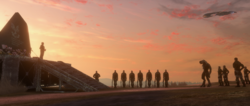
Following the final battle of the war on December 11, 2552,[18] the Human-Covenant War ended in a victory for humanity and their newfound Sangheili allies - the majority of the Covenant military having been defeated at Delta Halo by the Sangheili Fleet of Retribution, while the rest were annihilated by the joint Elite-UNSC forces at the Ark. This victory came in time to save the human homeworld, thanks chiefly to the actions of Arbiter Thel 'Vadam and Spartan John-117. The Human-Covenant War was officially declared over on March 3, 2553, when a memorial service was held near Voi, Kenya, to those fallen during the 27 years of fighting.[6]
In her inaugural speech in January 2553, President of the Unified Earth Government Ruth Charet outlined humanity's future and foreign policy, promising that they would rebuild as well as stating that humanity would now reclaim their "rightful place in the universe". While humanity was willing to coexist with other species, they would never again allow themselves to be the victims of alien aggression. While the official stance within the government and the military was to build peace with the Sangheili, the UNSC's Office of Naval Intelligence covertly worked to neutralize the Sangheili, whom they considered the most acute threat to human primacy.[19]
The end of the Covenant War did not spell a lasting peace for humankind and new conflicts soon began to emerge. Various Covenant remnants, most prominently the new Covenant order led by Jul 'Mdama, initiated their own campaigns against humanity in addition to renewed internecine conflict sparked by resurgent Insurrectionist movements such as the New Colonial Alliance. The UNSC fared significantly better against these significantly weaker incarnations of the Covenant, with improved assets and technology, such as the UNSC Infinity and the SPARTAN-IVs, at their disposal proving an advantage for the recovering UNSC. In 2557, after both parties stumbled upon the shield world of Requiem, the conflict was joined by Promethean forces led by a surviving Forerunner known as the Didact, who once commanded the Forerunner armies against prehistoric humanity in the Human-Forerunner War. Allied with the modern Covenant, the Didact defied the Forerunners' decision to pass down their Mantle to humanity by continuing his previous genocidal campaign. During the conflict, contact was also made with mankind's ancient benefactor, the Librarian, who had archived her personality and memories to assist humanity to guide them in their ascension to the Mantle. The Didact attempted to digitize humanity with the Composer, but was defeated at the last minute by John-117 and his AI Cortana,[7] though seven million human lives were lost.[20] By October 2558 Earth and most human colonies were taken over by the Created.[21]
Biology
Anatomy and physiology
Humans are mammals, and are closely related to other large apes on the planet Earth. Like all placental mammals, they are warm-blooded and give birth to live offspring, and nourish their offspring with milk. They have five fingers, one being an opposable thumb. This hand structure aided them in making tools early in their history.
Unlike Sangheili, their circulatory system is closed and consists of one heart and a network of blood vessels. They have red blood due to their iron-based hemoglobin, as well as two lungs which breathe mainly a nitrogen-oxygen based atmosphere. Externally they have more hair than most Covenant species, but not nearly as much as Jiralhanae. They have an average sense of sight, but compared to Covenant species a poor sense of hearing and smell. They are omnivorous, meaning that they will eat both meats and plants, as well as consume high calcium foods, such as the milk of other animals.
Their bone structure is calcium-based and is designed to withstand moderate stresses, but is generally weaker than the skeletons of Jiralhanae and Sangheili. Their muscular system is, on average, also weaker than most large Covenant species. If in extreme distress, humans can tap into hidden reserves of energy, known as an adrenaline rush, thus giving them drastically increased strength. This response is known as the "Fight or Flight" reflex.
In theory at least, physical conditioning can still negate the disadvantages of human physiology somewhat, and with the right enhancements and equipment, humans can overcome their physical disadvantages to an even further extent as demonstrated by the Spartans. Biological augmentation is not restricted to the Spartans; humans have routinely used bioengineering technologies for centuries, first to adapt to different conditions encountered in space and on other worlds, as well as a certain degree of enhancement given to military personnel.[22] However, such enhancements do not provide as immediately conspicuous increase in physical prowess as those of the Spartans.
Forerunner connections
- Main article: Reclaimer
Although the human and Forerunner genera exhibit a number of anatomical and physical similarities, they evolved independently on different worlds and are not genetically related. However, the Forerunners themselves were intrigued by the similarities between their own race and humanity. Because of their similarities, some Forerunner scholars theorized that humans were a kindred species, created by the Precursors in their own image, just as the Forerunners believed themselves to be.[4]
The Forerunners chose humans to become the inheritors of their technology along with Forerunners' sacred Mantle, which they formerly believed to have inherited from the Precursors. The Forerunners re-encoded certain aspects of their technology (e.g. the activation index) to only respond to human DNA to stop their advanced technology getting into the hands of other races. In a mixture of guilt and hope, they passed the torch to humanity, in hope that in the future they would defeat the Flood again, which with some help, John-117 did. The Librarian imprinted the human race with a geas, a pattern of information hidden deep in the genetic code and passed on throughout generations.[4] According to the Librarian, this imprint triggered the development of many technologies which proved critical to the survival of humanity after their contact with the Covenant, as well as containing several latent abilities.[23] This may also explain the "natural" understanding of Forerunner interfaces some humans have demonstrated despite having no prior contact with Forerunner technology.[24] Latent human memories and patterns extracted during the Conservation Measure were also implanted into the genetic code of future human generations.[25][26]
Despite this, many Forerunner AI constructs seem to regard humans as Forerunner (although some fail to do so).[27] This confusion was also the root of the Covenant's campaign to exterminate humanity. In 2525, a Covenant missionary ship traveled the edge of Covenant-controlled space and discovered a planet that was covered with Forerunner "Reclamation" glyphs, who were actually the humans. Later, a report of the planet's glyphs was sent to the Vice Minister of Tranquility. He took the information to the Minister of Fortitude and he went to see the Oracle (the Forerunner AI, Mendicant Bias, in the Forerunner Dreadnought). Upon activation of the "Oracle", the AI proclaimed, "FOR EONS I HAVE WATCHED. LISTENED TO YOU MISINTERPRET. THIS IS NOT RECLAMATION. THIS IS RECLAIMER. AND THOSE IT REPRESENTS ARE MY MAKERS. I WILL REJECT MY BIAS AND WILL MAKE AMENDS. MY MAKERS ARE MY MASTERS. I WILL BRING THEM SAFELY TO THE ARK." Truth, believing that the humans were actually Forerunners (rather than their inheritors), became panicked and realized that this information could destroy the foundation of the Covenant and, with it, his power. Utilizing his power as High Prophet, Truth proceeded to launch a massive religious crusade against humanity, the Human-Covenant War. At the end of the war, when Truth was preparing to force Sergeant Major Avery Johnson to activate the Halo Array, he still believed humans to be the Forerunners' literal descendants, saying "Your forefathers wisely set aside their compassion. Steeled themselves for what needed to be done. I see now why they left you behind. You were weak. And gods must be strong."[28]
Culture and society

On a superficial level, human culture has changed little since the 21st century. As before, humanity remains multicultural amongst its still marginally independent nations on both Earth and the colonies, although on the whole it has been heavily influenced from what was once thought of as Western culture. The United Nations Space Command, in particular, draws heavily from the former United States of America in terms of military practices and tradition, combined with the continued adoption of English as humanity's lingua franca, although other languages remain in use among human populations. Humans continue to practice a number of religions, although apart from several exceptions faith is largely considered a personal matter. Several cultural phenomena have emerged following the 21st century, including the prevalent flip music, the styllight musical instrument, and Cosmic Commedia Cooperative, a form of 25th-century absurdist theater.
There is virtually no segregation or discrimination evident among humanity on the basis of gender or ethnic group. In contrast to common practices in the 21st century, males and females serve in the military in an equal capacity; showers and housing facilities are likewise shared.[29][30] The absence of old cultural and racial hatreds within the UEG-governed humanity hearkens back to the philosophy that gave rise to it in the 22nd century, when the extremist Frieden and Koslovic ideologies threatened to consume all of humankind.[31]
Much like the cultural changes wrought by the colonization of the Earth in the past, space colonization has its own unpredictable effects on the cultures of colonial populations. While some colony worlds are multicultural from the beginning, others receive the majority of their colonists from a given region or nation on Earth, which often makes its own mark on the development of the colony's own culture. As populations settle new worlds, cultures distort and sometimes amalgamate; however, it is common for the locals to consciously hold on to their Earth cultural heritage. This often takes the form of naming the colony world's locales after the native region or local mythology of its inhabitants. Examples of such worlds include Reach, colonized by Hungarian settlers, Madrigal, with its predominantly Hispanic population, or Harvest, which fashioned its culture after the American-Scandinavian ancestry of the majority of its colonists. Over time, colonial cultures tend to retain several very conspicuous traits of their roots while others are forgotten or altered; cultures essentially become "parodies" of what they used to be.[32] Meanwhile, many of the Outer Colonies, especially those with settlers from highly varied and unregulated backgrounds,[33] appear as more chaotic hodgepodges of cultures with no single distinct origin culture in evidence. This has become all the more pronounced on independent worlds such as Venezia after the Human-Covenant War as former client species of the Covenant intermingle with the local human populations.[34]
The UNSC's predominance casts a distinct air of militarism over most of humanity; military service and heroism are glorified to great lengths by UNSC propaganda, as well as the media. While the press evidently enjoys some degree of freedom,[35] the media is heavily regulated by ONI's Section Two. The UNSC adopted its policy media control after the Inner Colony Wars, when sensationalist news reports of the conflict spread mass panic and threatened to dismantle Earth's culture.[36] This aspect of humanity strengthened with the UNSC's establishment as humanity's emergency government and the unfolding of the Human-Covenant War, and shows little signs of fading following the end of the war. These practices, combined with the UNSC's policy with the colonies, have elicited accusations of totalitarianism in elements of the population, and are often pointed out by colonial secessionists in their own propaganda.
Homeworld and colonies
- Main articles: Earth, human colonies
Having possessed slipspace travel for over two centuries, humanity's sphere of influence has expanded to cover a sizable region of space surrounding their home system. These colonies are roughly divided amongst the Inner Colonies and Outer Colonies; the former consisting of the 210 worlds colonized between 2362 and 2390, and the Outer Colonies encompassing all colonies established afterward. At its height, around the 2490's, human space encompassed 800 worlds, ranging from thriving hubs of commerce and military to various lesser worlds which mostly existed to provide the core worlds with resources and foodstuffs, as well as yet smaller outposts and settlements. A significant number of these worlds were glassed by the Covenant over the course of the Human-Covenant War.[5]
While all colonies are formally represented equally within the Unified Earth Government, the true power is often perceived to rest on the Inner Colonies and Earth. This has led to widespread separatism and even civil war, and many Outer Colonies have declared themselves independent from the UEG over the decades. Because many of the colonies are invaluable to the core worlds due to the resources they produce, the UEG has historically sought to maintain its control over them by any means necessary, including military intervention, which in turn provoked the colonial insurgents all the more.[5]
Population
In October 2552, Cortana said that humanity suffered 23 billion casualties throughout the course of the Human-Covenant War, making it the minimal amount of humans alive before the war. The exact time frame and objective accuracy of this number is unknown.[37]
Earth was deemed overpopulated in the 22nd century, jump-starting the colonization programs at the time.[38] Despite the colonization efforts made to resolve the overpopulation issue, Earth's population still remained in the billions.[39] The population of Earth prior to the Battle of Earth was at an approximate 10 billion: the population was said to have been cut in half at the start of the Covenant attack.[2][40] By the end of the battle, the population count was reduced to 200 million; this was both due to casualties inflicted by the Covenant as well as a massive off-planet evacuation effort.[41][42] Following the end of the Human-Covenant War, the population of Earth increased dramatically due to the influx of returning evacuees and refugees from other worlds, being again in the billions by the end of the year 2553.[41]
Technology
Prior to the human-Forerunner wars, humanity had achieved a remarkably advanced technological state, having developed interstellar travel, colonized thousands of worlds outside of their solar system,[43] and even having an understanding of Precursor technology. However, nearly all records and examples of this former technology were obliterated following their war with the Forerunners. Humanity managed to develop rudimentary technology such as steam power roughly nine thousand years after their defeat.[4] Unfortunately, this technological and cultural development proved to be in vain: during a phase after the Conservation Measure's reintroduction stage, aptly termed as the dark time,[2] the species regressed back into hunter-gatherers for over 90,000 years until the development of the modern human civilizations first began.
In early stages, human technology and knowledge advanced through simple trial and error in an inefficient manner, hampering faster progress. Although humans had developed writing very early on in their history, it was not until the invention of printing that information and ideas could be mass-communicated in an effective manner. The development of the scientific method in later conjunction with improved and more efficient capitalistic resource management techniques during the lessons of the Industrial Revolution resulted in stark accelerations in the development of technologies and the acquisition of knowledge. New technologies were experimented and explored with advanced knowledge of underlying principles as talented individuals were better organized and better supplied, allowing extremely accurate and fast improvements to be made with minimized trials and costs. Such methods of thought and organization are a hallmark of humanity which differs from the Covenant who, lacking proper researching methods, would simply copy and reverse-engineer technology from ancient Forerunner artifacts via the Huragok, whilst generally having no understanding of the underlying concepts themselves. Thus it it was said that the Covenant are "imitative" while the humans are "innovative" as the war progressed.[44]
By the 26th century, human technology has not advanced equally for every concept previously explored. The most basic technologies (such as the ballistic weaponry and the wheel) have undergone few principal changes, the explanation for this being their proven reliability over centuries of use. The technology worked and so did not require heavy alteration or major changes. However, certain significant advancements have been made in other fields, such as Shaw-Fujikawa Translight Engines that allow ships to reach other star systems, as well as the creation of highly sophisticated AIs that can serve to fulfill a versatile amount of roles. In addition, humans have also developed various forms of nanotechnology which allows many advances impossible with conventional engineering. Other common construction materials include polycrete, permacrete and instacrete.
Human technology has undergone further advancements as a result of the reverse-engineering of Covenant and Forerunner technologies at the close and aftermath of the Human-Covenant War. These include, among other things, significant improvements in slipspace navigation and velocity as well as improved offensive and defensive weapons technologies, such as the more widespread adoption of energy shielding.[7][19] Thanks to technology received from the Swords of Sanghelios and Kig-Yar merchants researchers were able to leapfrog centuries of trial-and-error experimentation and theory building.[45]
AI, robotics and automation
Human AI constructs can be grouped into two main categories; "dumb" and "smart" AIs. These labels are technically misleading, as both types are extremely intelligent, but dumb AIs are only capable of learning about subjects within their designated area of expertise, whereas smart AIs exhibit much more human-like characteristics, such as emotions, creativity and intuition. Smart AIs can only be created by scanning a human brain and replicating the neural pattern to a digital storage system known as a Riemann matrix. However, after seven years of operation, the AI will descend to a terminal condition known as rampancy. Various solutions have been attempted to counter this issue, but none are known to have been effectively implemented.[46]
Although the UNSC still relies heavily on human combatants, robotic drones are used in combat to a certain extent, often providing fire support or real-time reconnaissance on the battlefield. Examples of UNSC drones include the F-99 Wombat, the MAKO and ARGUS drones.[47]
In civilian society, automated systems—sometimes controlled by the subprocesses of a larger AI—have found uses in piloting civilian vehicles as well as performing most manual labor in agriculture and industry.[48] The scale of AI-driven automation ranges from single cities to entire worlds; the former sometimes operated by a "dumb" AI such as the Superintendent while "smart" AI Mack's oversight of Harvest's agricultural operations is an example of the latter.
Medical advances and biotechnology
Humanity has mastered a number of medical technologies, improving the quality of life in general but also providing many military applications. Among the most prominent is flash cloning, which allows the re-growth of almost any body part and is often used to replace damaged or lost organs.[49] Lost limbs may also be replaced with advanced mechanical prosthetics.[50] Humans have been effectively immunized against some conventional diseases, including cancer. Though isolated cases of cancer still occur, they can be easily treated.[51] Medical science has resolved most issues with eyesight, although some people choose to wear glasses for a variety of reasons, among them the ability to use them to project a heads-up display.[52]
On long slipspace voyages, humans use cryo chambers, allowing the occupant to enter cryonic suspension which effectively stops biological aging for the duration of the journey. These and many more advances have continued to push human longevity beyond prior estimates; with flash-cloned organ transplants, coupled with time spent in cryosleep, one's biological age may be decades less than their chronological one.[53]
The use of sterile field generators means that surgery is not only safer to perform, with a greatly reduced risk of infection, but is also able to be performed in the field. Even critical injuries can be treated with relatively limited facilities;[54] with sufficiently sophisticated equipment such as that of the UNSC Hopeful, the resuscitation of individuals traditionally considered dead is not unheard of.[55] Biological death can also be delayed by placing an individual into cryonic suspension until proper medical care can be provided.[56] A number of synthetic compounds have been developed to allow more rapid recovery from injuries or to ease the treatment of patients in general; these include biofoam, bone-knitting polymer, and polymerized hemoglobin.
Humans have also adopted a variety of bioengineering and augmentation technologies. The first widespread use of biochemical augmentation was implemented in the early days of human space travel, to help humans adjust to long-duration spaceflight and different planetary environmental conditions. Subsequently, human enhancements saw military application in the first interplanetary conflicts.[22] While human enhancement has been commonplace for centuries, more extensive augmentation or experimentation has been limited due to ethical concerns. An exception to this are the biochemical and cybernetic augmentations used in the SPARTAN programs, which represent the peak of human medical technology in the field of biological enhancement. Human rebels also use "rumbledrugs", which degenerate the user's body but grant them superhuman abilities for a short time.[51]
UNSC personnel are equipped with neural implants, more sophisticated models of which—typically issued to ship captains—enable a human mind to interface with computer systems and receive or send information. The neural marker is an interviewing device which can record an individual's thoughts and visualize them on a monitor.[57] Cognitive Impression Modeling allows the translation of a human brain's neural framework into digital form for the purpose of creating AIs, although this is not true mind transfer in the manner of that employed by the Forerunners: the resulting intelligence is not a perfect copy of the person it was created from due to the chaotic process in which the AI is brought into being.[46]
Space-faring
During the mid-20th century, humanity experimented with rocket technology using it to build satellites and visit and subsequently colonize the Moon and beyond in the latter half of the 21st century. With the advent of Shaw-Fujikawa Translight Engines allowing faster-than-light travel, the UNSC was able to expand well beyond the confines of the Solar System, colonizing hundreds of worlds. UNSC freighters transport food and goods between colonies, while UNSC Navy warships protect trade routes from pirates and defend colonies from enemy assault. Space elevators are used on many worlds to provide orbital transport. Advanced terraforming and climate control techniques have been developed, making human habitation possible even in many formerly hostile environments.
Human spacecraft are typically equipped with nuclear fusion engines for subluminal propulsion. These drives provide thrust via expelling either the fusion reactor exhaust or some other form of reaction propellant through a series of thruster nozzles. They are capable of remarkable thrust, allowing ships to cross interplanetary distances in a matter of hours, although gravity-assist maneuvers are commonly used to an advantage.[58][59] Rocket thrusters using triamino hydrazine as propellant are used for attitude control and small-scale maneuvering.[60] In addition to visual stealth systems, UNSC prowlers are able to use "engine baffles" to completely mask their emission profiles to match the surrounding space while running with reduced engine power.[61]
Humanity also employs a variety of gravity-manipulating technologies, including two forms of artificial gravity aboard spacecraft and space stations. The first is a system of rotating "carousel" sections which generate an approximation of gravity through centrifugal force. There is also a form of artificial gravity which does not require moving parts, but this technology consumes enormous amounts of power and spinning sections are generally regarded as being more efficient.[62] Some UNSC ships, such as Phoenix-class colony ships or UNSC frigates are equipped with a form of anti-gravity technology, as evidenced by their ability to operate in a planetary atmosphere without the use of thrusters.[63] Not all ships are equipped for atmospheric operation, however.[64] Anti-gravity is not typically implemented on craft smaller than warships and conventional engine systems are used to produce lift instead.[65]
While the weapons and combat abilities of human spacecraft were still very limited by the time of the Human-Covenant War, the reverse-engineering of Covenant and Forerunner technologies has subsequently granted humanity multiple advances in these technologies.[19]
Weapons
While still primarily based on projectiles and chemical reactions, human weapons are more advanced than the weapons of the 21st century. They come with a variety of electronic gadgets such as ammo readouts and are significantly more reliable, seldom malfunctioning. They are also generally immune to electromagnetic pulses. Still, there have been many advanced developments, such as electromagnetic accelerator weapons. The most prominent of these is the Magnetic Accelerator Cannon, used as the main armament on UNSC warships, and in smaller form in ground-based weapons. Another electromagnetic weapon system, known as the railgun, is used to a lesser degree. There have been developments in energy weapons such as the Spartan Laser and the pulse lasers used on UNSC prowlers. Advances in technology allow the development of highly efficient explosive devices, including the Lancet micro-missiles, capable of decimating main battle tanks.[47]
One of the largest breakthroughs came in the mid-20th century where humans discovered that nuclear fission and fusion can be used as a weapon to cause a large explosion. By the 26th century, there are several types of nuclear weapons in the UNSC's arsenal, intended for both atmospheric and exoatmospheric use. Innovation in this area would also converge in the creation of humanity's most devastating weapon during the war effort, known as the NOVA bomb.
Vehicles
Though human vehicles still rely on crude wheeled or continuous track motion for locomotion, UNSC vehicles are still extremely advanced, incorporating high-strength materials with precision engineering to improve mobility and durability, while often mounting a variety of weapons or equipment to increase their flexibility. Most have switched from fossil fuels to hydrogen-fuel cell engines or at the very least use hybrid-electric engines for enhanced fuel efficiency. The most powerful of human vehicles usually run on continuous tracks that allow them to better distribute their weight over uneven ground and to better grip uneven terrain thus allowing for the vehicles to go places where other wheeled counterparts could never, but the vehicles are usually heavier than their wheeled counterparts.
Most UNSC aircraft are designed with Vertical Take-off and Landing capabilities, using adjustable jet engines for lift and thrust. It is possible that some incorporate lifting body principles.
Communications
By the end of the Covenant War, humanity had developed superluminal communications systems enabling instantaneous communication and data transfer across interstellar distances.[66] Prior to this, the primary form of long-range communication was limited to manually delivering the messages to the recipient by carrying messages aboard starships.[67] For short-range communications, humanity employs conventional radio, as well as tight-beam laser[68] and maser-based systems.[60] The various human communication systems are commonly shortened to "COM".[68]
Gallery
Human skeletons in Halo 5: Guardians' Forge
Various humans in Halo Wars 2.
List of appearances
Sources
- ^ a b c d e f g h Halo Waypoint: Humans
- ^ a b c Halo 3, Bestiarum
- ^ a b Halo: Silentium, Rebirth Narrative
- ^ a b c d e Halo: Cryptum
- ^ a b c d e f g Xbox.com/Halo
- ^ a b c Halo 3
- ^ a b c d Halo 4
- ^ Halo: Primordium, page 194
- ^ a b Halo: Silentium
- ^ Halo: Silentium, pages 67-68
- ^ Halo: Primordium, page 237-238
- ^ Halo: Primordium, page 375
- ^ Halo: Fractures, "Promises to Keep", pages 84-85
- ^ Halo: Reach, Data pads
- ^ Halo: The Flood, page 17
- ^ Halo 2, Conversations from the Universe
- ^ Halo 2, campaign level Cairo Station
- ^ Halo Waypoint: Hero-Fortitude
- ^ a b c Halo: Glasslands
- ^ Halo: Escalation, Issue 7 official summary
- ^ Halo 5: Guardians
- ^ a b Halo Encyclopedia, page 44
- ^ Halo 4, campaign level Reclaimer
- ^ Halo: The Flood, page 84
- ^ Halo: Silentium, page 57
- ^ Halo: Primordium, page 379
- ^ Halo Wars, campaign level Cleansing
- ^ Halo 3, campaign level The Covenant
- ^ Halo: The Fall of Reach, pages 14-15 (2001 edition)
- ^ Halo 4: Forward Unto Dawn
- ^ Halo Waypoint: The Halo Bulletin 5.14.14
- ^ Halo: Mortal Dictata, page 13
- ^ Halo: Evolutions, "The Impossible Life and the Possible Death of Preston J. Cole", page 428-429
- ^ Halo: Mortal Dictata
- ^ Noble Team performance reports — Emile-A239
- ^ Halo Graphic Novel, Second Sunrise Over New Mombasa
- ^ Halo Evolutions, Palace Hotel, page 351
- ^ Halo Encyclopedia, page 42
- ^ Halo Encyclopedia, page 282 ("Billions still live there despite the ongoing colonization of the stars.")
- ^ Halo Encyclopedia, page 282 ("... the entire population of Earth was cut in half as the First Battle of Earth began.")
- ^ a b Twitter: @HaloWaypoint Hey, what was the population of Earth prior to November 2552?
- ^ Twitter: @HaloWaypoint Just picked up the Essential Visual Guide. Is the post war population of 200,000,000 on Earth still canon?
- ^ Halo: Primordium, page 129
- ^ Halo: The Flood, page 132
- ^ 1/22/2016: Armory Amore
- ^ a b Halo: Reach, Dr. Halsey's personal journal
- ^ a b Halo: Contact Harvest, page 16
- ^ Halo Encyclopedia, page 42 (2011)
- ^ Halo: Evolutions - Essential Tales of the Halo Universe, "The Impossible Life and the Possible Death of Preston J. Cole", page 461
- ^ Halo: Contact Harvest, page 81
- ^ a b Halo: Evolutions - Essential Tales of the Halo Universe,"Midnight in the Heart of Midlothian"
- ^ Halo Waypoint: The Halo Bulletin: 4.16.14
- ^ Halo: Evolutions - Essential Tales of the Halo Universe,"The Impossible Life and the Possible Death of Preston J. Cole", pages 485-486
- ^ Halo: First Strike, page 140 (2003 edition)
- ^ Halo: Ghosts of Onyx, page 97
- ^ Halo: The Fall of Reach, page 329 (2001 edition)
- ^ Halo 3: ODST Pre-mission Evaluation
- ^ Halo: The Fall of Reach, pages 324-329
- ^ Halo: The Fall of Reach, page 17
- ^ a b Halo: Contact Harvest, page 25
- ^ Halo: Ghosts of Onyx, page 43
- ^ Halo Encyclopedia, page 211
- ^ Halo 3, campaign level, The Storm
- ^ Halo: The Flood, page 40
- ^ Halo: Ghosts of Onyx, page 135
- ^ Data Drop
- ^ Halo: Contact Harvest, page 35
- ^ a b Halo: Ghosts of Onyx, page 50


